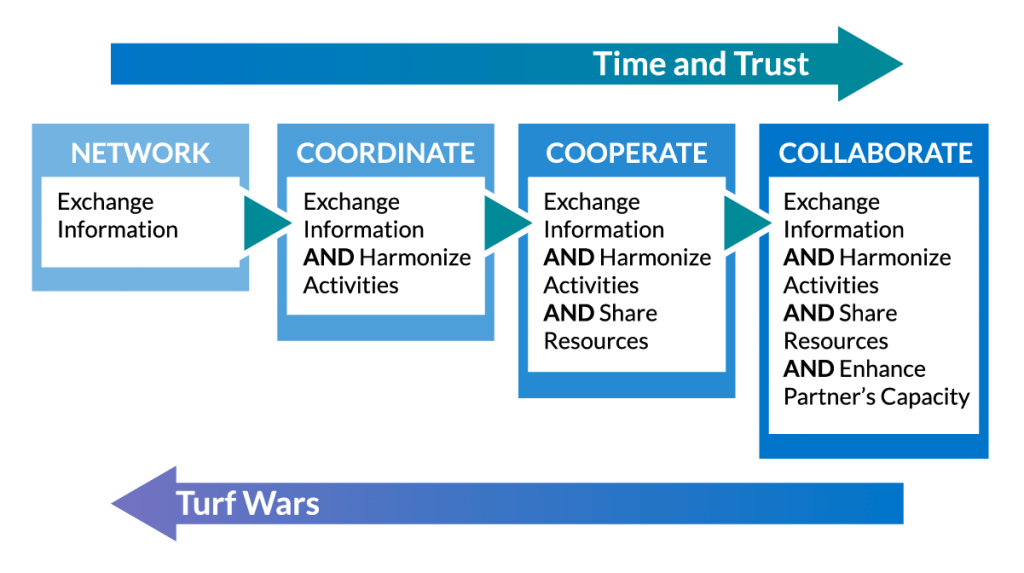
There are no modules in this training course.
Creating partnerships for information sharing
What is the role of partnerships in information sharing?

Rarely is one organization or agency solely responsible for the collection of all CAMH data. For example, CAMH data could be collected by schools, hospitals, or juvenile justice agencies, to name just a few. Building and maintaining effective partnerships across both governmental and non-governmental partners enhances the ability to assess, monitor, and improve CAMH. Effective partnerships can lead to:

- Given how scattered CAMH data are across sectors, pooling data from disparate partners and sources could provide a more complete picture of CAMH. Each partner brings their own perspective and expertise on CAMH, yielding a deeper understanding of the challenges, solutions, and possible interventions that can lead to improved understanding of the data.
- A combination of data sharing and use agreements, memoranda of understanding (MOU), or other mechanisms to clarify the proposed purpose and use of data are usually created at the start of the partnership to lay the groundwork for the future. PHII’s Information Governance for Public Health provides guidance that could be incorporated into such partnership agreements.
- Working with partners can enhance understanding and use of the proposed data and indicators to assess and improve CAMH. Working with organizations that collect or maintain these data can help all partners to understand the strengths and limitations of the data. The data can reveal answers about prevalence, underlying causes, or areas of interest. The data and indicators can also help identify specific populations or subpopulations that might need additional support. The National Association of State Boards of Education’s How Schools Work & How to Work with Schools provides guidance and tips for effectively working with schools.
- Working with partners can enhance understanding and use of the proposed data and indicators to assess and improve CAMH. Working with organizations that collect or maintain these data can help all partners to understand the strengths and limitations of the data. The data can reveal answers about prevalence, underlying causes, or areas of interest. The data and indicators can also help identify specific populations or subpopulations that might need additional support. The National Association of State Boards of Education’s How Schools Work & How to Work with Schools provides guidance and tips for effectively working with schools.
 Partnerships can be leveraged to enhance funding by using a layered approach.
Partnerships can be leveraged to enhance funding by using a layered approach.
Building information partnerships can help leverage, layer, pool, and diversify funds for CAMH from multiple sources. Such partnerships might not be easy to create, but most funders—governmental or philanthropic—value collaborative partnerships and appreciate evidence of established partnerships. As a result, working with partners can appeal to funders and even open doors to funding opportunities that public health alone would not receive.

The image below illustrates the value of spending time with partners through the stages of networking, coordination, cooperation, and collaboration to build or enhance trust. As partners move from one stage to the next, the level of trust among partners and the benefits of the partnership increase.
Regular and honest communication is important for improved trust. Communicating the benefit each partner will receive and their role in assessing and improving CAMH will help to create a valuable partnership. More information will be provided on how to determine the benefit and role of each partner in the section below. Tip<i>Effective communication is key to building and maintaining productive partnerships, and listening is key to effective communications. All partners can benefit from honing their listening skills, which allow us to not only hear but also pay attention to the messages and stories of others. These messages and stories often include valuable information and might even provide insight into solutions for common challenges. </i>
Federal funding
Federal organizations that provide funding for mental health activities and research include the Centers for Disease Control and Prevention (CDC), National Institutes of Health (NIH), National Institute of Mental Health (NIMH), Substance Abuse and Mental Health Services Administration (SAMHSA), Health Resources and Services Administration (HRSA) and the Centers for Medicare and Medicaid Services (CMS).
Health departments can benefit from identifying and reaching out to form partnerships with other agencies that are funded by these types of organizations. Additional information about organizations that provide mental health funding specifically for research can be found here.


What strategies can be used to identify and engage partners?
As previously noted, partnerships can expand the resources, knowledge, expertise, and support available to assess and monitor CAMH. Therefore, it is important to develop and use strategies designed to identify and engage partners. The following tips are provided to assist health departments in identifying and engaging partners to assess and improve CAMH.
Consider which partners could play a key role in:
- Increasing credibility and trust among current and potential partners (e.g., physicians’ associations, community organizations)
- Implementing the data sharing or other interventions that are central to the effort (e.g., state or local behavioral health agencies, schools and school districts, education agencies)
- Advocating for changes to institutionalize the data sharing or other interventions (e.g., advocacy groups for mental health, child welfare, physicians’ associations)
- Funding or authorizing continuation or expansion of data sharing or other interventions (e.g., legislators, policy-makers, federal government)
Consider which partners have relevant data.
- The CAMH indicators proposed in this playbook are based on data that are mostly found in schools and education agencies. Other indicators not referenced in this playbook are found in other settings. Partnerships between public health and schools that were created during the COVID-19 pandemic might be leveraged for purposes of data sharing related to the indicators outlined in this playbook.
- Professional associations related to child and adolescent health, such as the state chapter of the American Academy of Pediatrics (AAP), can be valuable partners. As such, health departments could benefit from efforts to learn what they are doing in the mental health and prevention realms and explore their willingness to share or exchange data.
- Data that comes from multiple settings or is of different types that is put together helps public health create the broader picture of CAMH.
Recognize that some partners might be especially well-suited to reach the target population.
- Seek partners who have already won the public’s trust and respect.
- It takes time to develop trust and respect. By identifying partners who are already trusted by the target population or within the community, they can reach out to their trusted advisors and invite them into the current child and adolescent mental health conversations without the need for your agency to develop the trust and respect on its own for these conversations to occur.
Oregon Health Authority teams up with the Children's Institute
The Oregon Health Authority collaborated with the Children’s Institute to involve healthcare in school readiness and identify incentive measures to include for the coordinated care organizations across the state. As a result, a social emotional component for the school readiness incentive measure will be implemented in 2022.
All coordinated care organizations will be required to meet the measure to receive an incentive. In the process, the Oregon Health Authority will receive aggregate-level data from each organization that will be used to monitor the extent to which kindergarten readiness improves due to the improved access to quality services.
Read more about the incentive measures and process.
What approaches can be used to identify champions?
Champions, internal or external to the health department, can help promote and support efforts to assess and improve CAMH. Using champions to promote health is an evidence-based practice that can be adapted for CAMH. Champions do not necessarily need to hold leadership positions within the organization. They can simply be passionate and dedicated individuals willing to put in effort to improve and advocate on behalf of the initiative. Qualities such as leadership, collaboration, and innovation may help champions overcome obstacles and cement key relationships.


Talking points for engaging partners and identifying champions
These key messages can be used when speaking to partners, the community, or internal leadership about the important role that public health can play in assessing and improving CAMH.
- All children have mental health.
Mental health is not a set of diagnosed disorders, and it is not the mere absence of a diagnosed disorder. It is the mental, emotional, and behavioral capacities in each child that equip them to function well where they live, learn, and play. Children’s mental health varies over time and is something that can be built, nurtured, promoted, and protected. As described in an early childhood mental health brief from Harvard, “Most potential mental health problems will not become mental health disorders if we respond to them early.” - Public health can play a key role in assessing and improving CAMH.
Public health is in a strong position to use its surveillance expertise to assess and improve CAMH and bring together groups of interested partners, bridging some of the silos. CAMH is influenced by multiple indicators, including genetics, prenatal exposures, adverse childhood experiences, social determinants of health, caregivers, and systems and policies. Due to the complex and diverse group of factors that influence CAMH, it is important for public health to identify and collaborate with a diverse group of partners to assess and improve CAMH. - There are indicators that can be used by public health to assess and improve CAMH.
Public health can use indicators such as school attendance, school disciplinary actions, and school readiness as a starting point to assess and improve CAMH. These indicators have the potential to provide useful information about the mental health and well-being of children and adolescents. They are based on data that are already being collected and can be used to monitor population-level CAMH at a wide range of child and adolescent ages (e.g., early childhood through high school).


